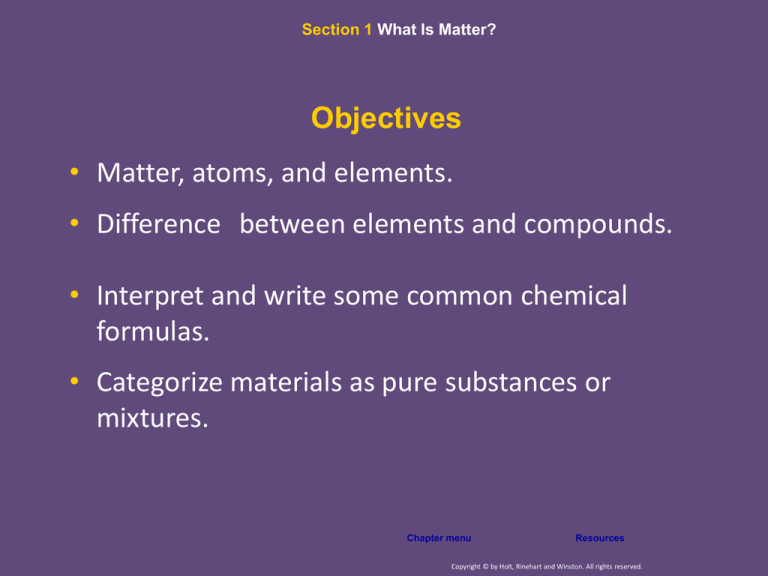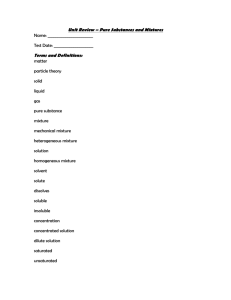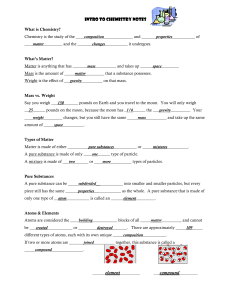
Section 1 What Is Matter?
Objectives
• Matter, atoms, and elements.
• Difference between elements and compounds.
• Interpret and write some common chemical
formulas.
• Categorize materials as pure substances or
mixtures.
Chapter menu
Resources
Copyright © by Holt, Rinehart and Winston. All rights reserved.
• Chemistry is the scientific study of the
composition, structure, and properties of
matter and the changes that matter
undergoes. (study of matter and how it
changes)
Section 1 What Is Matter?
Composition of Matter
• Matter is anything that has mass and takes up
space
• Atom the smallest unit of an element that
maintains the properties of that element
• Element a substance that cannot be separated
or broken down into simpler substances by
chemical means
Chapter menu
Resources
Copyright © by Holt, Rinehart and Winston. All rights reserved.
Section 1 What Is Matter?
• Elements combine chemically to form a
compound.
• Compound a substance made of atoms of
two or more different elements that are
chemically combined
Chapter menu
Resources
Copyright © by Holt, Rinehart and Winston. All rights reserved.
Section 1 What Is Matter?
Compounds
Chapter menu
Resources
Copyright © by Holt, Rinehart and Winston. All rights reserved.
Section 1 What Is Matter?
• When elements combine to form a specific
compound, they always combine in the same
proportions.
• Ex: water
Chapter menu
Resources
Copyright © by Holt, Rinehart and Winston. All rights reserved.
Section 1 What Is Matter?
•Atoms can join together to make molecules.
• Molecules are the smallest unit of a substance
that keeps all of the physical and chemical
properties of that substance.
Chapter menu
Resources
Copyright © by Holt, Rinehart and Winston. All rights reserved.
Section 1 What Is Matter?
•Chemical formulas represent compounds and
molecules.
•A chemical formula shows how many atoms
of each element are in a unit of a substance.
•Chemical formula a combination of
chemical symbols and numbers to represent a
substance.
Chapter menu
Resources
Copyright © by Holt, Rinehart and Winston. All rights reserved.
Section 1 What Is Matter?
Classification of Matter –
Pure Substances vs.
Mixtures
Chapter menu
Resources
Copyright © by Holt, Rinehart and Winston. All rights reserved.
Pure Substances
• Pure Substances: matter that has a fixed
(uniform and definite) composition
• Pure substances can only be separated by
chemical means
Pure Substances
Two types of pure substances• Elements: matter that is made up of only one
kind of atom
• Compounds: substance composed of atoms of
two or more elements that are chemically
bonded
Makeup of Elements and Compounds
• Atom: smallest representative particle of an
element. Cannot be broken by any chemical
means.
Atoms bond together to make molecules!
• Molecule: smallest representative particle of a
compound. A group of like or different atoms
composed of two or more atoms held together by
chemical bonds.
What kind of Pure Substance is this?
Table Salt (NaCl)
What kind of Pure Substance is this?
Mercury (Hg)
Mixtures
• Mixture: when two or more pure substances
combine but retain their individual properties
• Mixtures can be separated by physical means
Section 1 What Is Matter?
Mixtures are classified by
how thoroughly the
substances mix.
Chapter menu
Resources
Copyright © by Holt, Rinehart and Winston. All rights reserved.
Mixtures
Two Types of Mixtures• Homogeneous: mixture that is the same throughout.
Homogeneous mixtures only have one phase
• Heterogeneous: substance that isn’t uniformly mixed.
Heterogeneous mixtures have more than one phase
*Phase: area of uniform composition
Homogeneous Mixtures
• When substances dissolve and form a
homogeneous mixture, the mixture is called a
solution
• A solution is made up of a solute and a solvent
Solute: substance being dissolved, present in smaller
amount
Solvent: substance doing the dissolving, present in
larger amount
• If a material dissolves in a liquid the material is
said to be soluble
ex) sugar is soluble in water
Heterogeneous Mixtures
• Suspensions: solid particles in a suspension will easily
settle at the bottom of a container, upon standing
• Colloids: very small solid particles that do not settle
**Tyndall Effect: the scattering of light as a light beam
passes through a colloid. The individual suspension
particles scatter and reflect light, making the beam
visible.
https://www.youtube.com/watch?v=gheuYqQ6phE
What type of Mixture is this?
What type of Mixture is this?
Mixtures of two or more LIQUIDS
•Miscible substances that can be mixed
ex: alcohol and water
•Immiscible substances that cannot be mixed
ex: oil and water
Section 1 What Is Matter?
Comparing Miscible and Immiscible Liquids
Chapter menu
Resources
Copyright © by Holt, Rinehart and Winston. All rights reserved.
Classification of Matter
MATTER
(gas. Liquid,
solid, plasma)
PURE
SUBSTANCES
Separated by
MIXTURES
physical means into
Separated by
COMPOUNDS
ELEMENTS
chemical
means into
Kotz & Treichel, Chemistry & Chemical Reactivity, 3rd Edition , 1996, page 31
HOMOGENEOUS
MIXTURES
HETEROGENEOUS
MIXTURE
Classification of Matter
uniform
properties?
fixed
composition?
chemically
decomposable?
http://antoine.frostburg.edu/chem/senese/101/matter/slides/sld003.htm
no
heterogeneous
mixture
no
solution
no
element
yes
compound
Milk
Air: mixture of
gasses
Water (H20)
Wood
Element, Compound,
Heterogeneous Mixture, or Solution??
Liquid Nitrogen
Brass: mixture
of metals
Ocean Water
Chapter menu
Resources
Copyright © by Holt, Rinehart and Winston. All rights reserved.









